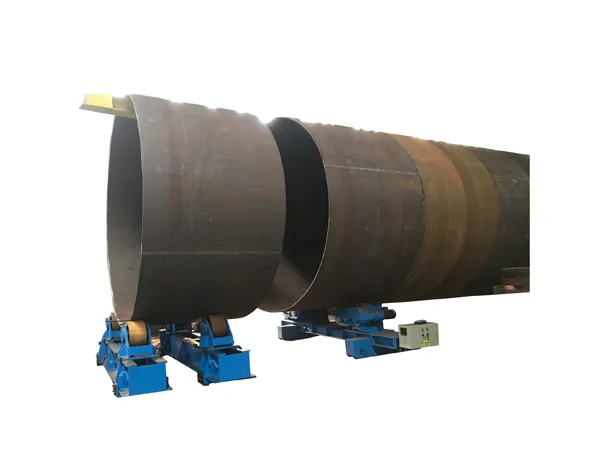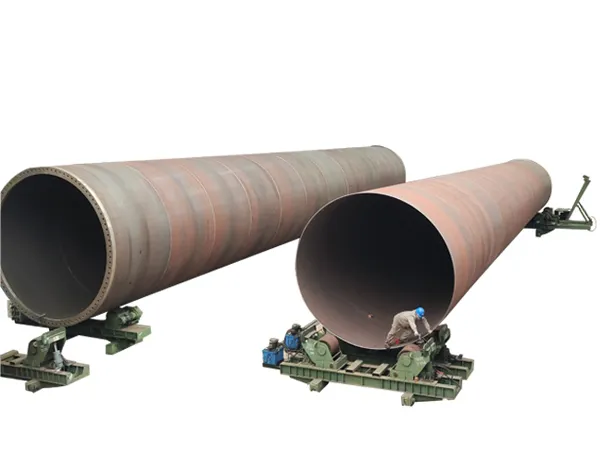Maintaining a welding rotator (also known as a turning roll or pipe rotator) is crucial for its longevity, safe operation, and consistent performance. Proper maintenance helps prevent breakdowns, ensures accurate rotation, and protects your investment.

Lockout/Tagout (LOTO): Before any maintenance, ensure the rotator is completely de-energized and locked out/tagged out to prevent accidental startup.
Personal Protective Equipment (PPE): Wear appropriate PPE, such as safety glasses, gloves, and steel-toed boots.
Stable Load: Ensure any workpiece is removed or securely supported before performing maintenance that could affect its stability.
Manufacturer's Manual: Always consult the specific manufacturer's manual for your model. This guide is general; your manual will have model-specific instructions and recommendations.
A. Daily / Before Each Use:
Visual Inspection:
General Cleanliness: Check for excessive dirt, grease, weld spatter, or debris. Clean as needed.
Rollers (Drive & Idler): Inspect for damage, wear, flat spots, or embedded foreign objects (slag, metal chips). Clean roller surfaces.
Cables & Hoses: Check power cables, control pendant cables, and any hydraulic/pneumatic lines for cuts, frays, kinks, or wear. Ensure they are not tripping hazards.
Control Panel/Pendant: Check for damage. Ensure all buttons, switches, and E-stops are functional and not sticking.
Guards & Safety Features: Verify all safety guards are in place and secure. Test the E-stop function.
Leaks: Look for any oil or grease leaks from gearboxes, bearings, or hydraulic systems.
Functional Check:
Smooth Operation: Briefly run the rotator (unloaded or with a light test piece) to check for smooth rotation, unusual noises (grinding, whining, clicking), or excessive vibration.
Speed Control: Verify that speed adjustments work correctly.
B. Weekly Maintenance:
Thorough Cleaning:
Clean weld spatter and debris from rollers, frame, and drive components. Use a wire brush, scraper (carefully to avoid damaging rollers), or appropriate cleaning agents.
Wipe down the control panel.
Roller Inspection & Cleaning:
More detailed inspection of roller surfaces. For polyurethane rollers, ensure no chemicals that could degrade the material are used for cleaning.
Check roller alignment (ensure they are parallel and idlers move freely if adjustable).
Fasteners:
Check critical bolts and screws for tightness (e.g., roller mounting bolts, motor mounts, gearbox mounts). Do not overtighten.
Lubrication (Check Levels & Points):
Gearbox: Check oil level if a sight glass or dipstick is present.
Bearings: Identify grease points (zerks) for roller bearings, drive shaft bearings, etc. (Actual greasing might be monthly or less frequent, depending on use and manufacturer recommendations).
Drive System (Chains/Belts):
Chains: Check tension, look for signs of wear (stretched links, stiff links), and ensure proper lubrication.
Belts: Check tension, look for cracks, glazing, or fraying.
Couplings: Inspect drive couplings between motor and gearbox for wear or damage.
C. Monthly Maintenance:
Lubrication (Perform):
Gearbox Oil: If level was low or oil looks contaminated (milky, dark, metallic particles), follow manufacturer's procedure for topping up or changing.
Bearings: Grease bearings according to the manufacturer's specifications for type of grease and frequency. Wipe off excess grease to prevent dirt accumulation.
Chains: Clean and lubricate drive chains.
Electrical System:
Connections: Inspect electrical connections inside the control panel (LOTO!) and at the motor for tightness and signs of corrosion or overheating. Only qualified personnel should perform this.
Brushes (DC Motors/Generators): If applicable, inspect motor brushes for wear and replace if necessary.
Structural Integrity:
Inspect the frame for any cracks, bends, or damage, especially around welds and load-bearing points.
Alignment:
Re-check roller alignment, especially if the rotator has been moved or subjected to heavy loads.
D. Annual / As Needed Maintenance:
Gearbox Oil Change: Even if the oil looks okay, change it per the manufacturer's recommended interval or if analysis indicates degradation.
Bearing Replacement: If bearings are noisy, have excessive play, or feel rough when turned by hand (with LOTO), they may need replacement.
Roller Replacement/Resurfacing: Replace or resurface rollers if they are severely worn, damaged, or out-of-round, affecting rotation quality.
Motor Service: Depending on the motor type and usage, it may require professional servicing.
Calibration (if applicable): For rotators with precise speed or positioning feedback, calibration may be necessary.
Full Electrical Inspection: A qualified electrician should conduct a thorough inspection of the entire electrical system.

Cleaning: Use brushes, scrapers, compressed air, and mild detergents. Avoid harsh solvents on polyurethane rollers.
Lubrication:
Grease: Use the type of grease recommended by the manufacturer (e.g., lithium-based, synthetic). Apply grease until fresh grease purges from the bearing seals, then wipe away excess.
Oil: Use the recommended gear oil viscosity and type. Ensure proper fill levels.
Inspection: Look for wear, damage, looseness, leaks, unusual noises, and improper operation.
Adjustment: This primarily applies to chain/belt tension and adjustable idler roller positions.
Jerky Rotation: Check for debris on rollers, worn rollers, loose drive components, or motor/control issues.
Unusual Noises: Pinpoint the source. Could be bearings, gearbox, motor, or loose parts.
Overheating Motor/Gearbox: Check for overloading, insufficient lubrication, poor ventilation, or electrical problems.
Rotator Not Starting: Check power supply, fuses/breakers, E-stop, control pendant connections.
Maintain a logbook for all maintenance activities, including dates, tasks performed, parts replaced, and any observations. This helps track history and schedule future maintenance.
By following a consistent maintenance routine, you'll significantly extend the life of your welding rotator and ensure it operates safely and efficiently. Always prioritize safety and consult your equipment's manual.
No. 1 Intersection of Chuangye Avenue and Weilai Avenue,
Yiyang County,Luoyang City, Henan Province, China
+86 400-0379-069
Copyright © 2023 An Automated Welding and Cutting Equipment Manufacturer Focusing on Welding Column Boom and Welding Rotator | All Rights Reserved Technical support: ShangXian